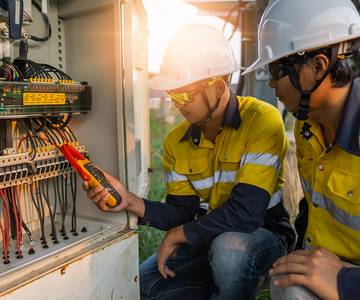
6 Safety Rules When Working with Electricity

Since its invention, electricity has been around our society for hundreds of years. Nowadays, we take electrical power for granted, flipping a simple switch and the lights come on automatically. It’s hard to imagine a time without electricity, and we have all come to enjoy the comfort it brings.
When used safely, electricity provides light, heat and automation to keep our world running. At work, all of our computers and office equipment run on electricity. Plus, the majority of factories and worksites cannot operate without stable connections to a power source.
As valuable as this power may be, it also poses a safety risk in the workplace. There are potential dangers when working with electricity, from minor burns to severe electrocution. However, electricity doesn’t have to be dangerous. With comprehensive health and safety training, workers will understand the guidelines that keep them safe from harm.
Whether you’re working in an office, a construction site, or a manufacturing plant, it’s crucial to ensure basic electrical safety in the workplace. To maximize protection, implement these six safety rules when working with electricity:
Safety Rule #1: Limit workplace access to electrical hazards.

Depending on where you work, there may be industrial equipment packed with enormous voltage. Access to electrical components should be by qualified personnel ONLY. In addition, there should be staff assigned to maintaining the equipment regularly and professionally, in accordance with manufacturer’s specifications and applicable regulations.
When working with high-voltage equipment, you should keep a safe distance. As a rule of thumb, conduct your work while avoiding any contact with voltage above 50V. When electricians are working on anything highly energized, they should put up a barrier to block staff from coming in proximity. There should be warning signs posted about the potential electrical safety hazards.
Safety Rule #2: Train employees on electrical safety in the workplace.

In all sectors, the safe handling and operating of any electrical equipment are essential. If not used properly, electricity can be dangerous and lead to potential injuries or fatalities. Before beginning any work, employees should learn some basic safety rules when working with electricity:
- Don’t overload electric sockets with extra splitters.
- Only pull out any cords by the head, not the cord itself.
- Keep liquids away from electrical devices and don’t touch plugs with wet hands.
- Don’t use cords with frayed wires or broken plugs.
The best way to ensure your employees understand electrical safety in the workplace is through professional training courses. The Electrical Safety Awareness course teaches workers about identifying, understanding, and avoiding the many electrical hazards at work. Successful candidates will receive the Electrical Safety Awareness Certificate of Completion to demonstrate their workplace knowledge.
Safety Rule #3: Be careful with flammable and / or combustible materials in the workplace.

If you store flammable material in your workplace, make sure it is away from any potential dangers. Watch out specifically for any combustible vapours, gases, or even dust. If you accumulate scrap paper or wood, it must be cleaned up regularly and stored safely. An electrical spark can easily ignite these materials, causing a fire in your place of work.
Your company should develop safe work procedures for the use of flammable materials. A Basic Fire Safety training course may be necessary to inform workers about prevention methods and appropriate emergency responses. In addition, conduct regular safety meetings to remind employees of the protocols when working with electricity.
Safety Rule #4: Maximize electrical safety with workplace equipment.

If you are working with electricity, it is crucial to keep yourself safe using the right tools and gear for the job. The appropriate equipment will prevent shocks and burns while handling electrical current or circuits. Whenever possible, your company should insulate any handheld electrical equipment. Plus, employees should wear rubber gloves and goggles to keep themselves safe.
Of course, only qualified personnel should have the clearance to work with electrical equipment. The workers need to have the training and knowledge to use, install, or maintain energized equipment.
Safety Rule #5: Use lockout systems.

When working with electrical components and live parts, equipment must be de-energized first. By isolating and turning off electricity, workers can safely make installations and repairs as needed. For specialized equipment, it is not enough to merely turn off the power. Implement a lockout system to ensure that you manage any hazardous energy appropriately.
A lockout device is a device/piece of equipment that secures the electrical equipment by isolating its energy. When the lockout is activated, it keeps the hazardous energy under control by locking the system in a safe mode. It might take the form of a circuit breaker, a disconnect switch, or any energy-isolating device. Only the employees doing the work should have the lockout keys, as they’re responsible for removing the locks when safe to do so.
Safety Rule #6: Be aware of overhead & underground electrical lines.

When working on a construction site, there are machines that dig and lift materials on a steady basis. Operators need to be aware of any live wires running above or below the machinery. Hitting or exposing a live current can instantly energize their machine, potentially causing electrocution.
As part of their construction safety training, employees should be aware of their surroundings and know where the electrical lines are running. Inside buildings, be mindful of wires running along or within the ceilings and the walls. Always be cautious when working in these spaces so that you don’t touch or sever any wiring unintentionally. If you have any concerns or questions, always refer to your immediate supervisor for guidance.

